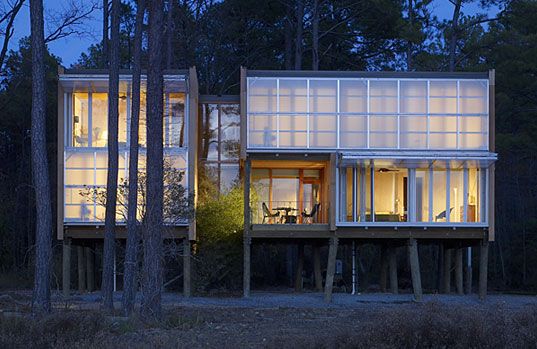I spent a few days last week at the University of Massachusetts–Amherst, attending the
2008 Wood Structures Symposium. Like many smaller conferences, it was pretty invigorating, with conversations from sessions spilling into the hallway coffee breaks. The theme this year was prefabricated architecture, a particular interest of mine, and there were lots of new ideas floating around.
One of the overriding ideas of the symposium was the notion of mass customization. Instead of seeing each building as a unique entity, we could start seeing buildings as collections of standard parts put together in different ways. The standard parts--panels, structural systems, heating systems, and so on--could be assembled in factories and sent to the site. Building assemblies with integrated electrical wiring and plumbing could save time on site. In this way, the construction industry could come to look more like the car or airplane industry.
Streamlining the industry in this way would have several benefits. First, it would provide safer working conditions for employees. In a factory setting, roofers work six feet above the ground, siding is put on at ground level, and panels can be oriented to provide comfortable working conditions for plumbers and electricians. Done properly, this sort of construction could also be more efficient and use less transportation-related fuel to erect a building on-site. Working with a kit of parts, rather than fully-designed models, architects and builders could customize a building to work with a site and a certain aesthetic ideal.
Moving towards this model could put a lot of builders out of work, since constructing a building in a factory requires fewer workers than stick-building on site. Some of these workers would still be needed for renovation work, and others could be trained in renewable energy design, installation, and maintenance.
Imagining this type of industry in a variety of situations, however, I think it holds a lot of promise. Think of an industry similar to the car or airplane industry mobilized in the wake of a natural disaster: housing units, rather than travel trailers, could be in place in weeks and months, not years. (Think of the retooling of the car industry to provide planes and weapons during World War II.) Onsite construction on urban lots could take a few weeks, keeping traffic and parking disruption to a minimum. Impact on undeveloped lots could be kept to a minimum as well, keeping more trees and groundcover intact. Workers could be guaranteed a certain number of hours each week as well as health insurance and better working conditions. Done right, the construction-industry-as-factory could benefit almost every segment of the industry as well as the environment.
(Image: The
Loblolly House, KieranTimberlake Associates. The Loblolly house is a prototype of what could happen with a streamlined construction industry.)


Add new comment
To post a comment, you need to register for a BuildingGreen Basic membership (free) or login to your existing profile.